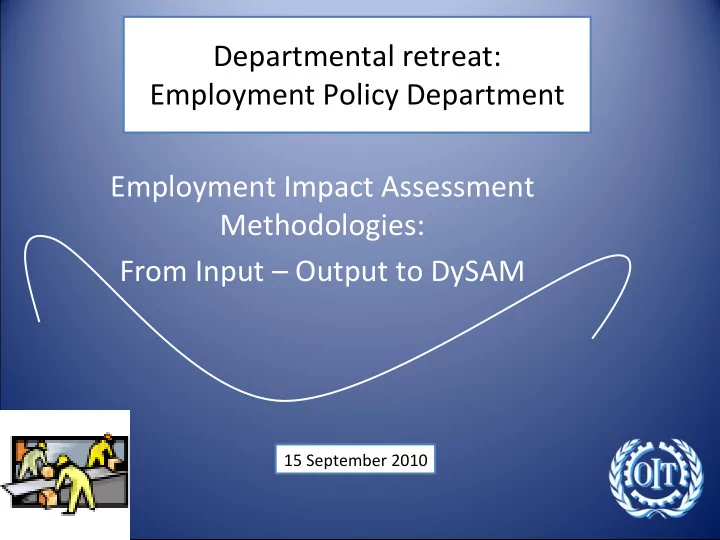

Departmental retreat: Employment Policy Department Employment Impact Assessment Methodologies: From Input – Output to DySAM 15 September 2010
Integration of Employment in Public Investment Programmes in Infrastructure PROGRAMMING AND BUDGETING PROCESS Tools & Methodologies for impact assessment to analyse economic growth, household income and consumption, employment, multiplier effects, balance of payment, etc. 3. Negotiation, arbitration and finalisation of budget proposals Ministry of 2. Preparation 4- Political and priority Planning/Finance process and setting of approval of programmes Employment Investment the budget Unit 1. Macroeconomic framework Programme formulation guidance I ‐ Preparation, impact assessment and approval of programme proposals Investments in Investments in Investments Investments Investments in Agriculture Environment in Public Works in Education decentralisation Sector Protection Sector & Health & regional Sector Sectors development Tools & Methodologies for Capacity Building and sectoral analysis of major technical options using the 3 criteria: (i) unit cost, (ii) employment and incomes, (iii) foreign exchange: local expenditure vs. import (in the preparation, selection and prioritisation of programmes)
Evolution • The (Dy)SAM is the result of a natural evolution of analytical EIA tools developed and used by Emp/Invest during the last 30 years • It is based and adds up on previous used tools, which have shown their effectiveness, but also certain limitations the (Dy)SAM intends to overcome
Production Consumption Consumption Wages Wages O U T P U T O U T P U T I I N N Transfers Transfers Social transfers Social transfers P P Subsidies/credits Subsidies/credits Taxes Taxes U U Social transfers Social transfers T T Institutions Institutions Enterprises Households Households Enterprises Government Government
Expanded and extended SAM Activities Monetary Construction Expansion values SAM SAM Employment satellite Employment satellite Real values
DYSAM 2010 Time dimension 2009 2008 Static: One specific year
Dynamic SAM • Static SAM: Snapshot of the economy • Dynamic SAM: consistent evolution of the economic structure over time (incl. income and techn. coefficients) • To create a dynamic SAM, need for forward ‐ looking projections of key macro & financial variables, derived from macro SAM and flow ‐ of ‐ funds
What is the outcome of it? Impact analysis of: Impact analysis of: on targets: on targets: •Formal/informal •Formal/informal •Rural/Urban •Rural/Urban Workers Workers •Gender/youth •Gender/youth •Public investment: •Public investment: •Skill level •Skill level e.g. infrastructure e.g. infrastructure Ex ante •Green jobs •Green jobs •Social transfers/prot. •Social transfers/prot. •Private investment •Private investment •Decile/quintile •Decile/quintile •Sectors/sect. policies •Sectors/sect. policies Ex post •Rural/urban •Rural/urban Households Households •Heads of HH •Heads of HH •Gender •Gender Direct, indirect and induced employment effect Direct, indirect and induced employment effect
Who will use the DySAM ? • CMEA: Infrastructure investment • Public Works: Construction satellite account • Finances: Climate change/green jobs • Planning: Climate change, growth and employment (youth emp) • Bank of Indonesia: Climate change & remittances (social fin.) • Manpower: FDI and employment • BPS: Hosting and up ‐ dating DySAM • ILO projects : Trade and employment, green jobs • Proposals on regional DySAMs • UNWTO: Tourism satellite account
Conclusion • It can do a lot, but not all macro, meso, micro e.g. monet. policy, project monitoring • Helpful analytical tool for policy advise: • Evaluation of effectiveness of past policies • Decision ‐ making on future policies & mix of policies • Targeting of specific groups (of workers) or indicators (e.g. MDG) • Bring employment considerations into decision ‐ making process of various Ministries • Potential for Social Dialogue • Way forward: Extension & expansion Issues: technological change, green jobs/climate change, social protection, sectoral disaggregation Method: Provincial/local DySAMs, dynamic investment Training: ILO staff, local constituents, trainers of trainer
Christoph Ernst ernst@ilo.org
Additional material
Comparative Table Static SAM DySAM Method Deman ‐ driven multiplier framework on accounting platform (input ‐ output + social transfer) SAM + time series (dynamique), some behaviours Data required high: SNA, FoF, LFS, HS very high: same as static SAM + time series for macro variables Level of analysis Macro ‐ meso ‐ micro + interlinkages Macro ‐ meso ‐ micro + interlinkages Applicability Ex post impact evaluation, ex ante simulation: public investment, spending, policies, exogenous shocks Ex post impact evaluation, ex ante simulation: public investment, spending, policies, exogenous shocks Inputs required Data, skilled staff, simple software + hardware Data, skilled staff, dynamic software Costs Construction 1 ‐ 3 w/m international, 3 ‐ 5 w/m national consultant 2 ‐ 6 w/m international, 4 ‐ 7 w/m national consultant Period implementation Construction: 1 ‐ 6 months, Training: 2 days ‐ 4 weeks Construction: 1 1/2 ‐ 6 months, Training: 2 days ‐ 4 weeks Strengths SAM+ dynamic + some behaviours full socio ‐ economic circle, micro ‐ meso ‐ macro, techno choices, employment account Weaknesses Technical coefficient fix, strong assumptions Data and skill requirements, still fixed prices Challenges Starting costs: Financial resources + national commitment Starting costs: Financial resources + national commitment
Recommend
More recommend